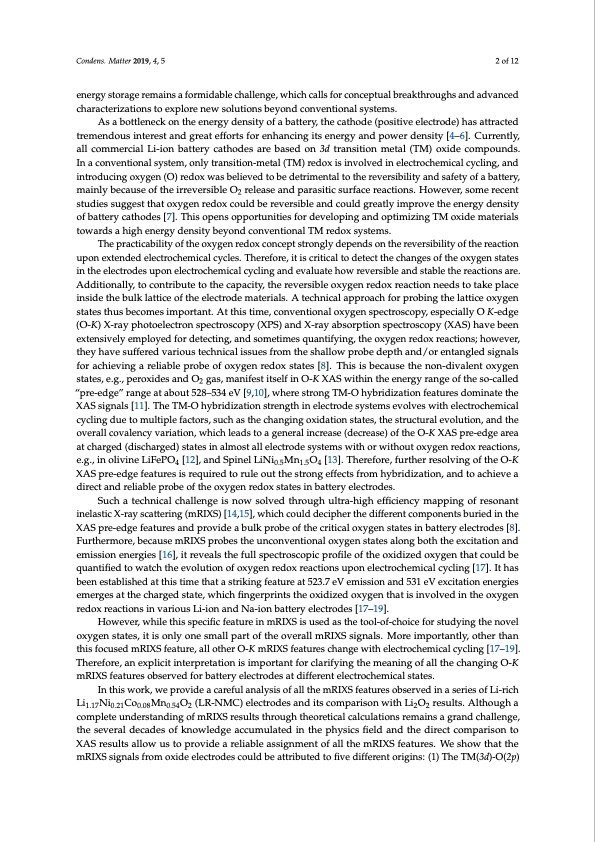
PDF Publication Title:
Text from PDF Page: 002
Condens. Matter 2019, 4, 5 2 of 12 energy storage remains a formidable challenge, which calls for conceptual breakthroughs and advanced characterizations to explore new solutions beyond conventional systems. As a bottleneck on the energy density of a battery, the cathode (positive electrode) has attracted tremendous interest and great efforts for enhancing its energy and power density [4–6]. Currently, all commercial Li-ion battery cathodes are based on 3d transition metal (TM) oxide compounds. In a conventional system, only transition-metal (TM) redox is involved in electrochemical cycling, and introducing oxygen (O) redox was believed to be detrimental to the reversibility and safety of a battery, mainly because of the irreversible O2 release and parasitic surface reactions. However, some recent studies suggest that oxygen redox could be reversible and could greatly improve the energy density of battery cathodes [7]. This opens opportunities for developing and optimizing TM oxide materials towards a high energy density beyond conventional TM redox systems. The practicability of the oxygen redox concept strongly depends on the reversibility of the reaction upon extended electrochemical cycles. Therefore, it is critical to detect the changes of the oxygen states in the electrodes upon electrochemical cycling and evaluate how reversible and stable the reactions are. Additionally, to contribute to the capacity, the reversible oxygen redox reaction needs to take place inside the bulk lattice of the electrode materials. A technical approach for probing the lattice oxygen states thus becomes important. At this time, conventional oxygen spectroscopy, especially O K-edge (O-K) X-ray photoelectron spectroscopy (XPS) and X-ray absorption spectroscopy (XAS) have been extensively employed for detecting, and sometimes quantifying, the oxygen redox reactions; however, they have suffered various technical issues from the shallow probe depth and/or entangled signals for achieving a reliable probe of oxygen redox states [8]. This is because the non-divalent oxygen states, e.g., peroxides and O2 gas, manifest itself in O-K XAS within the energy range of the so-called “pre-edge” range at about 528–534 eV [9,10], where strong TM-O hybridization features dominate the XAS signals [11]. The TM-O hybridization strength in electrode systems evolves with electrochemical cycling due to multiple factors, such as the changing oxidation states, the structural evolution, and the overall covalency variation, which leads to a general increase (decrease) of the O-K XAS pre-edge area at charged (discharged) states in almost all electrode systems with or without oxygen redox reactions, e.g., in olivine LiFePO4 [12], and Spinel LiNi0.5Mn1.5O4 [13]. Therefore, further resolving of the O-K XAS pre-edge features is required to rule out the strong effects from hybridization, and to achieve a direct and reliable probe of the oxygen redox states in battery electrodes. Such a technical challenge is now solved through ultra-high efficiency mapping of resonant inelastic X-ray scattering (mRIXS) [14,15], which could decipher the different components buried in the XAS pre-edge features and provide a bulk probe of the critical oxygen states in battery electrodes [8]. Furthermore, because mRIXS probes the unconventional oxygen states along both the excitation and emission energies [16], it reveals the full spectroscopic profile of the oxidized oxygen that could be quantified to watch the evolution of oxygen redox reactions upon electrochemical cycling [17]. It has been established at this time that a striking feature at 523.7 eV emission and 531 eV excitation energies emerges at the charged state, which fingerprints the oxidized oxygen that is involved in the oxygen redox reactions in various Li-ion and Na-ion battery electrodes [17–19]. However, while this specific feature in mRIXS is used as the tool-of-choice for studying the novel oxygen states, it is only one small part of the overall mRIXS signals. More importantly, other than this focused mRIXS feature, all other O-K mRIXS features change with electrochemical cycling [17–19]. Therefore, an explicit interpretation is important for clarifying the meaning of all the changing O-K mRIXS features observed for battery electrodes at different electrochemical states. In this work, we provide a careful analysis of all the mRIXS features observed in a series of Li-rich Li1.17Ni0.21Co0.08Mn0.54O2 (LR-NMC) electrodes and its comparison with Li2O2 results. Although a complete understanding of mRIXS results through theoretical calculations remains a grand challenge, the several decades of knowledge accumulated in the physics field and the direct comparison to XAS results allow us to provide a reliable assignment of all the mRIXS features. We show that the mRIXS signals from oxide electrodes could be attributed to five different origins: (1) The TM(3d)-O(2p)PDF Image | Oxygen Redox Reactions in Batteries Resonant Inelastic X-ray Scattering

PDF Search Title:
Oxygen Redox Reactions in Batteries Resonant Inelastic X-ray ScatteringOriginal File Name Searched:
condensedmatter-04-00005.pdfDIY PDF Search: Google It | Yahoo | Bing
Sulfur Deposition on Carbon Nanofibers using Supercritical CO2 Sulfur Deposition on Carbon Nanofibers using Supercritical CO2. Gamma sulfur also known as mother of pearl sulfur and nacreous sulfur... More Info
CO2 Organic Rankine Cycle Experimenter Platform The supercritical CO2 phase change system is both a heat pump and organic rankine cycle which can be used for those purposes and as a supercritical extractor for advanced subcritical and supercritical extraction technology. Uses include producing nanoparticles, precious metal CO2 extraction, lithium battery recycling, and other applications... More Info
| CONTACT TEL: 608-238-6001 Email: greg@infinityturbine.com | RSS | AMP |